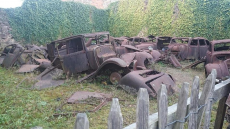
Email: nadege.preston@hotmail.com
Total Article : 82
About Me:Hi I’m Nadege and I study French at the University of Leeds, and I have just completed my third year abroad in Montpellier studying literature and enjoying the sunshine! I love art; painting and being creative, as well as photography and baking. Travelling is my favourite hobby at the moment; experiencing the French language and culture. I hope you enjoy reading some of my articles!

It is probably best to warn you that this article about the village of Oradour-sur-Glane will not be the jolliest. Having said this, I strongly advise any of you, whether a lover of history or not, to visit this World War II site to simply pay your respects and to acknowledge the horrors of war. Personally, I found this village the most moving and somber of places due to the horrific tragedy which took place. Oradour-sur-Glane is the old part of the town, and remains untouched since the day it was destroyed by the German SS; the 10th June 1944. Charles de Gaulle ordered it to remain untouched, so that it could be remembered in years to come. The first sign you see as you enter the village states; ‘Souviens-toi’/’Remember’ and that is the simple purpose of this village; to remember those who sadly lost their lives.
The village is consequently a memorial, and you enter through a visitor centre, but obviously there is no entrance fee. Oradour-sur-Glane is located in the department Haute-Vienne which is slightly west of the centre of France. As previously mentioned, on the fateful day, 642 people lost their lives – they were massacred by the Germans (a German Waffen-SS company). The village was sealed off, people were killed, and then the village was looted and every building set on fire. It is said that the SS rounded up all the people from the village for an ‘identity check’ which turned out to actually have the purpose of unarming any people with possible weapons. During this process, they ordered the women and children to wait in the church, and the men in barns, therefore families were separated. Using gas, fire arms such as machine guns and grenades, the SS destroyed and killed the entire village – and if some bodies had not been killed, the SS covered them in wood or fuel whcih was then set alight. However, one lady named Madame Rouffanche managed to escape, using a ladder, and although she was shot at numerous times, she managed to hide herself. She dug a hole in the soil, and laid there until the following day. From her memories she notes that; “At around four o’clock, a few soldiers brought a large box, with a few strings trailing out of it, into the nave. The strings were lit and the device suddenly exploded with a loud bang. It gave off a thick, black, suffocating smoke.” Yet, during this event, in the smoke, Mme Rouffanche miraculously escaped through the church window. I also believe that five men managed to escape, though wounded.

The reason why this massacre took place is uncertain. I have not heard of any concrete evidence as to why this fateful day happened. Walking round the village, it feels strange to see the tram tracks and the telephone lines remaining. Walking through the streets, you notice that every burnt house or shop has a plaque with the name of the owner, and how many people may have been killed in each building. As you walk around there are still machinery and objects remaining such as cars, rusty prams, the frames of bikes, sewing machines and utensils. Additionally, bullet holes in the church are clearly visible and noticing such things really does bring historical events to life in your mind. Consequently, actually being a witness yourself to the remains of the massacre, and seeing how brutally the village was destroyed and how many people were killed, it truly brings previous studied events to life.
On reflection, this was a truly poignant visit, one which was heart-breaking, but also one which I recommend. It was a true insight into the scope of the atrocity the German SS caused.
IMAGE 1 - personal image. The streets of the village.
IMAGE 2 - personal image. The remains of cars.

0 Comment:
Be the first one to comment on this article.